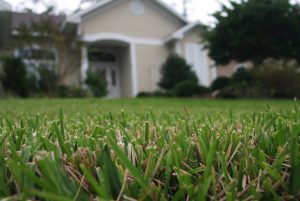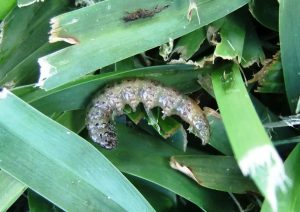
As we move into the mid-summer period, your lawn should be looking its best – a result of long periods of daylight, ample rainfall and warm nights. Lawns have recovered from the stress of the winter season and we have not quite yet arrived at the time when we experience the stress of too much rain, too much growth, too much thatch and all the “too much of a good thing” that leads to problems as fall approaches. Each grass, St. Augustine, Zoysia, Bahia or Centipede has different specific things that should be done to manage it, but there are several common elements that should be done regardless of which grass type you have. Attention to these items will lessen the chance of turf problems heading into late summer.
Mowing Your Grass
First mow at the proper height for your grass. A good rule of thumb is never to remove more than a third of the leaf blade when you make your cut. In this period of quicker growth, this probably means stepping up the frequency of mowing, for some grasses as often as every four or five days depending on rate of growth. Keeping mower blades sharp is an important element in how grass performs. By mid-summer you should be on your third or fourth sharpening for the calendar year, depending on the amount of mowing you have done.
Irrigation
Next, if you have not done so already, turn off all irrigation. We typically receive good rain amounts in July and August and additional irrigation can lead to disease issues. Remember that rains are not guaranteed and summer showers can be very spotty. One portion of town can receive a downpour while another part of town receives nothing. If you do experience a period of dry weather for a week or more it may be necessary to run a supplemental irrigation cycle. This is especially important in mid-summer because sun rays are very direct, temperatures are very hot, days are at their longest and grass is actively growing, so will be easily stressed if a period of several days pass and no moisture is received. Monitor rainfall and grass conditions and react accordingly to prevent stress.
Fertilizer
Fertilizer is recommended for actively growing turf at different rates, depending on the specific grass. If your program calls for a mid-summer nitrogen application be sure to use the appropriate amount and select a slow-release option to enhance nitrogen uptake. Remember to apply one quarter inch of water immediately following the application to prevent oxidation and to get nutrients into the root zone.
Insects
 As summer progresses insect populations build and life cycles progress more quickly in the warm temperatures. Mid – late summer favors insect development, so scout your lawn every couple (two) days. Look for light green or yellowing in the grass in a small, circular area as an early indication that there may be a problem. For chinch bugs, pay particular attention to areas along sidewalks and driveways as these populations often begin adjacent to concrete or blacktop and work their way outward. Caterpillars (armyworm and webworm) are chewing insects, so examine turf for thinning areas and look closely to determine if leaf blades have been chewed. Early detection and timely response is a critical element in preventing substantial insect damage.
As summer progresses insect populations build and life cycles progress more quickly in the warm temperatures. Mid – late summer favors insect development, so scout your lawn every couple (two) days. Look for light green or yellowing in the grass in a small, circular area as an early indication that there may be a problem. For chinch bugs, pay particular attention to areas along sidewalks and driveways as these populations often begin adjacent to concrete or blacktop and work their way outward. Caterpillars (armyworm and webworm) are chewing insects, so examine turf for thinning areas and look closely to determine if leaf blades have been chewed. Early detection and timely response is a critical element in preventing substantial insect damage.
Turf Diseases
Often when turf dies disease is suspected. Because identification and management of diseases requires experience that is beyond the scope of most people who are outside the turf profession, use of fungicide products is discouraged for home landscapers. The key to managing disease in most turf species is prevention – following the cultural practices that have been described above. If you suspect a disease – take-all root rot, large patch, Pythium root rot, etc., obtaining the assistance of a professional company is probably your best course of action. They have the experience, equipment and access to products that are most likely to obtain the results you want – halting a problem before it goes too far, and restoring turf to a healthy state.
Mid-summer, when lawns should be at their healthiest, is an excellent time to note the condition of your turf and to re-commit to regular scouting for problem intervention as we move into late summer and early fall.
 0
0
